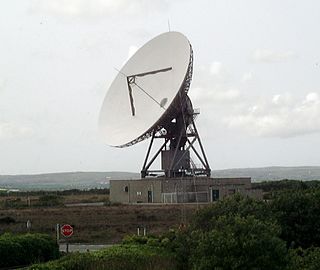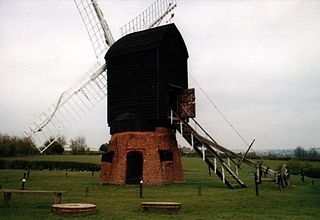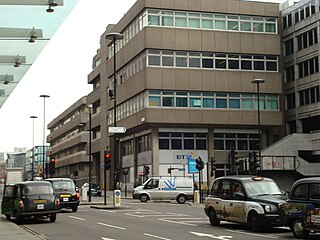Related Research Articles
BT Group plc is a British multinational telecommunications holding company headquartered in London, England. It has operations in around 180 countries and is the largest provider of fixed-line, broadband and mobile services in the UK, and also provides subscription television and IT services.

Goonhilly Satellite Earth Station is a large radiocommunication site located on Goonhilly Downs near Helston on the Lizard peninsula in Cornwall, England. Owned by Goonhilly Earth Station Ltd under a 999-year lease from BT Group plc, it was at one time the largest satellite earth station in the world, with more than 30 communication antennas and dishes in use. The site also links into undersea cable lines.
Telecommunications in the United Kingdom have evolved from the early days of the telegraph to modern fibre broadband and high-speed 5G networks.
The General Electric Company (GEC) was a major British industrial conglomerate involved in consumer and defence electronics, communications, and engineering.

Amberley Museum is an open-air industrial heritage museum at Amberley, near Arundel in West Sussex, England. The museum is owned and operated by Amberley Museum and Heritage Centre, a not-for-profit company and registered charity, and has the support of an active Friends organisation. The items in the Museums collection are held by The Amberley Museum Trust

The red telephone box is a telephone kiosk for a public telephone designed by Sir Giles Gilbert Scott, the architect responsible for Liverpool Cathedral.

The BT Tower is a grade II listed communications tower in Fitzrovia, London, England, owned by BT Group. It has also been known as the GPO Tower, the Post Office Tower, and the Telecom Tower. The main structure is 581 feet (177 m) high, with aerial rigging bringing the total height to 620 feet (189 m).

The Science and Industry Museum in Manchester, England, traces the development of science, technology and industry with emphasis on the city's achievements in these fields. The museum is part of the Science Museum Group, a non-departmental public body of the Department for Digital, Culture, Media and Sport, having merged with the National Science Museum in 2012.

Avoncroft Museum of Historic Buildings is an open-air museum of rescued buildings which have been relocated to its site in Stoke Heath, a district of Bromsgrove, Worcestershire, England. Founded in 1963 and opened in 1967, the museum was conceived following the dismantling of a 15th-century timber-framed house in Bromsgrove in 1962 to provide a location for its reconstruction. It became England's first open-air museum and, after the St Fagans National Museum of History in Wales, the second in the United Kingdom. This building is known as the medieval 'Town House' today, though it has been known by other names in the past, including the 'Bromsgrove House' and the 'Merchant's House'. It now houses a collection of domestic, industrial, agricultural and other forms of historic building, the majority dismantled and re-erected.

The Australian Museum, originally known as the Colonial Museum or Sydney Museum. is a heritage-listed museum at 1 William Street, Sydney CBD, New South Wales. It is the oldest natural history museum in Australia and the fifth oldest natural history museum in the world, with an international reputation in the fields of natural history and anthropology.

A ground station, Earth station, or Earth terminal is a terrestrial radio station designed for extraplanetary telecommunication with spacecraft, or reception of radio waves from astronomical radio sources. Ground stations may be located either on the surface of the Earth, or in its atmosphere. Earth stations communicate with spacecraft by transmitting and receiving radio waves in the super high frequency (SHF) or extremely high frequency (EHF) bands. When a ground station successfully transmits radio waves to a spacecraft, it establishes a telecommunications link. A principal telecommunications device of the ground station is the parabolic antenna.

The BT Archives is an archive preserving the documentary heritage of the British telecoms company BT and its public sector predecessors. It is designated an official place of deposit for Public Records, for those records created prior to BT's privatisation in 1984.

The National Film and Sound Archive of Australia (NFSA), known as ScreenSound Australia from 1999 to 2004, is Australia's audiovisual archive, responsible for developing, preserving, maintaining, promoting, and providing access to a national collection of film, television, sound, radio, video games, new media, and related documents and artefacts. The collection ranges from works created in the late nineteenth century when the recorded sound and film industries were in their infancy, to those made in the present day.

Adastral Park is a science campus based on part of the old Royal Air Force Station at Martlesham Heath, near Ipswich in the English county of Suffolk.

The Lapworth Museum of Geology is a geological museum run by the University of Birmingham and located on the university's campus in Edgbaston, south Birmingham, England. The museum is named after the geologist Charles Lapworth, its origins dating back to 1880. It reopened in 2016 following a £2.7 million redevelopment project that created new galleries and displays, as well as modern visitor and educational facilities.

Telecommunications engineering is a subfield of electronics engineering which seeks to design and devise systems of communication at a distance. The work ranges from basic circuit design to strategic mass developments. A telecommunication engineer is responsible for designing and overseeing the installation of telecommunications equipment and facilities, such as complex electronic switching system, and other plain old telephone service facilities, optical fiber cabling, IP networks, and microwave transmission systems. Telecommunications engineering also overlaps with broadcast engineering.

BT Research is the research arm of BT Group, formerly part of the British Post Office. The company was first established in 1921 as the Post Office Research Station at Dollis Hill, London. In 1968 BT moved of its research to the new site at Martlesham Heath based on part of the old Royal Air Force Station at Martlesham Heath near Ipswich in the English county of Suffolk, which was later renamed Adastral Park.

The Centre for Computing History is a museum in Cambridge, England, established to create a permanent public exhibition telling the story of the Information Age.

The BT Museum was a telecommunications museum run by BT, that held artefacts and exhibits on the history of telecommunications in the United Kingdom. It was based in Baynard House in the Blackfriars district of London.

The archaeology of Wales is the study of human occupation within the country of Wales which has been occupied by modern humans since 225,000 BCE, with continuous occupation from 9,000 BCE. Analysis of the sites, artefacts and other archaeological data within Wales details its complex social landscape and evolution from Prehistoric times to the Industrial period. This study is undertaken by academic institutions, consultancies, charities as well as government organisations.
References
- 1 2 "Connected Earth: How communication shapes the world". Engaging with Communication. Retrieved 17 October 2023.
- 1 2 "Connected Earth". UK: Amberley Museum . Retrieved 17 October 2023.
- ↑ "BT Connected Earth Collection". Collection. UK: Science Museum Group . Retrieved 17 October 2023.
- ↑ "BT Connected Earth Collection". JSTOR . Retrieved 17 October 2023.
- ↑ "Information". UK: Telecommunications Heritage Group. Retrieved 17 October 2023.
